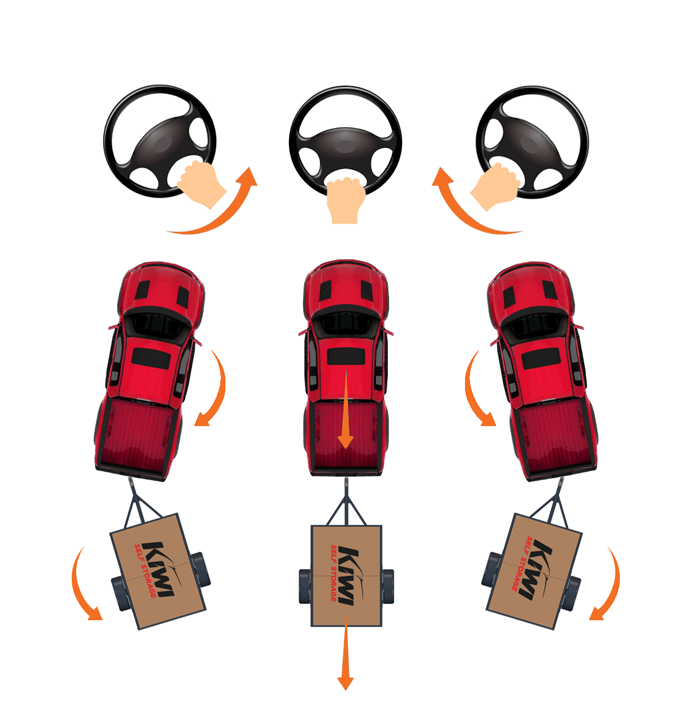Tips to safely use a trailer

As a part of making our customers’ self storage experience as easy as possible, each of our Wellington and Auckland storage facilities have trailers which customers are able to use for moving items in and out of their self storage units.
Using a trailer does take some getting used to so we’ve put together some tips for safely using our trailers for your stored items.
Getting started
Does your vehicle have a tow ball? (Also known as a tow bar or hitch) This might sound funny, but you’ll be surprised how many people arrive to use one of our trailers, only to discover they have nothing to attach it to! To use one of our trailers you will need:
An approved tow ball. In New Zealand there are two sizes of tow balls - the New Zealand standard 1”7/8ths ball (47.55mm) and the 50mm ball which is commonly found on European or American manufactured vehicles. All our trailers are fitted with the NZ standard 1”7/8ths coupling. (also known as a hitch) You will not be able to use a 50mm tow ball.
A working electrical connection for lights. Trailers are not to be used if this connection is not working or you do not have a compatible connection
We also like our drivers to be experienced at backing a trailer and have backed a trailer in the last 12 months.
Pre-checks when collecting the trailer
Make sure to hitch the trailer correctly
Place the trailer to face your tow ball, and back your vehicle up close enough to your trailer.
Secure the tow ball over the coupling using the locking mechanism. This locking mechanism might vary from trailer to trailer. Double check that the tow ball will not come off once this is done.
Secure the safety chain to your vehicle using the D shackle screwed in tightly. This safety feature is designed to keep the trailer attached to your vehicle if the trailer was to come off the tow ball.
Check the trailer tyres
At our self storage facilities we always try to ensure our trailers are ready to hit the road safely, but it always pays to do your own checks prior to driving away
Check the trailer lights and signals once hooked up.
It’s important that you check signal lights every single time before towing to ensure they’re in working condition. Ask someone to check the brake lights and indicator lights. If you are alone, feel free to ask one of our storage facility manager’s. Without working lights, other drivers will not know your intentions, which can lead to dangerous situations on the road.
Ensure you distribute the cargo weight correctly.
Load the trailer front with your heaviest load, placing around 60 % of the cargo closer to the front axle. The remaining 40 % can be loaded behind the axles. You also need the weight to be distributed evenly across each side. If the back of the trailer is much heavier than the front o, it can result in the trailer swaying, making it very difficult to control.
On the road
Being safe with a trailer means making adjustments while driving.
Reduce your speed. The trailer increases your vehicle's weight and length, so you need to adjust your driving style accordingly. By driving slower you will have more control over the vehicle and more space to make necessary decisions if needed.
Increase your following distance. More weight means it takes longer to slow down. You need to break sooner than you usually would to stop safely.
Make wider turns. If you use your usual turning radius your trailer will end up going over a lot of curbs. Ensure you allow for a wide berth, and keep an eye on your side mirrors.
Reversing
If you haven’t reversed a trailer before we’d recommend getting some practice in in a quiet area where you don’t feel pressured. This does take a bit of practice and sometimes goes against your instincts.

Firstly, be very aware of your surroundings and check for any potential obstacles.
Get an extra set of eyes. Even as an experienced trailer driver, having someone outside of the vehicle to help guide you takes a lot of pressure off.
Adjust your side mirrors. You want to be able to clearly see the rear of the trailer. Sometime even with making these adjustments it can be difficult to properly see the trailer.
Steering wheel hand position for turning. If your hands are in the 10 and 2 o’clock positions you will need to turn the steering wheel in the opposite direction to where you want it to go. A handy trick is placing your hands at the 6 o’clock position. That way your turn the steering wheel the direction you want the trailer to go.
Less is more for turning. Make slow steady adjustments for turning. If you try to turn to quickly the trailer will jack knife. If you can see this starting to happen, stop immediately to prevent the trailer corner damaging your vehicle.
Restart if you need to. If you feel like the trailer isn’t doing what you want, simply drive forward again and line yourself up to try again. Make any adjustments you feel necessary for the starting position, and mirrors. I possible position the vehicle so that you’ll be reversing towards the driver’s side of the vehicle. This will make things easier.
Remember the front of your vehicle. Even though you’re reversing, remember to keep an eye on the front of the towing vehicle. You don’t want to clip any obstacles with the front of your car while turning.
You should also watch this handy Youtube video produced by Hirepool:
If you're interested in booking one of our trailers, the best thing to do is call up your local facility and ask our friendly staff whether the trailers are available. Sometimes you don't need to book but we still recommend giving your storage facility a call and checking that one is available. Our manager’s will help you with the process, including signing a trailer hire agreement, and confirming your insurance.




